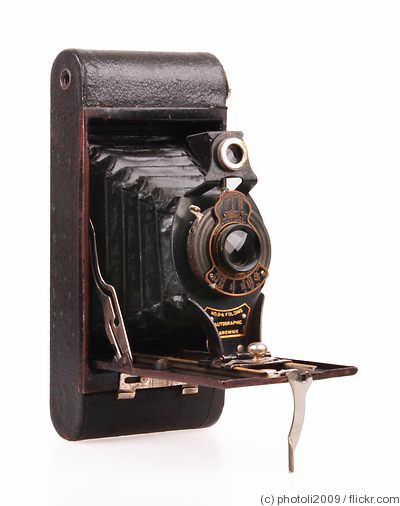Don't forget to update your personal camera inventory
Kodak Eastman: Folding Autographic Brownie No.2A
CollectiBlend Average Index
We don't have enough information to provide an accurate price for this camera, so this is the suggestion based on what we have. | ||||||||||||
| Camera rarity | ||||||||||||
Searching eBay listings: 
1915-1926. 120 film camera. Continuation of the Folding Brownie, but with an "Autographic" feature, which allowed photographers to sign a note on the top of the film (film was special too), which became visible after the film was developed.

Camera featured in these collections: luciferase Russell_Saburuko Fimdomundo Zely vcpayne salesnailde JakeC![]() mauro.corneo
mauro.corneo![]() bill339
bill339![]() rebel530 FPH Arndt Hanniesko
rebel530 FPH Arndt Hanniesko![]() Amuzed2death camerasofyesteryear Augusto Semjaja Moonman russwm
Amuzed2death camerasofyesteryear Augusto Semjaja Moonman russwm![]() Mosscat Zoloto
Mosscat Zoloto![]() Boender Oldsalt53
Boender Oldsalt53
converted and inflation-adjusted prices:
| Condition | Price | |||
| 2003-02-28 | $49 | |||
| 2002-01-01 | ~$17 | |||
Post a reply
The Kodak No. 2A Folding Autographic Brownie was a folding camera for type 116 Autographic film with a frame size of 2 1/2 × 4 1/4 inches. It was made by Canadian Kodak Co. Ltd in Toronto, Canada and in Rochester, NY, the USA by Eastman Kodak Company. The years of production were 1915 to 1926 and 210,000 were produced before 1921 but the final count is not known. The uncommon early square box design was replaced in late 1917 with the rounded edge cameras and the camera had a price of $9.00 in 1922. The shutter was either a Kodex no.1 shutter with speeds B, T, 1/25, 1/50 of a second, or Kodak Ball Bearing shutter with an additional 1/100 of a second speed for "moving objects", as the shutter says. The lens was either a Kodar 122mm f/7.8 or an f9 Bausch and Lomb rapid rectilinear. Aperture was marked "1", "2", "3", "4", "5", "6", "7", "8", "9" on early models and f7.9 to f22 on later models. The Bausch and Lomb version had f4 to f64. Focusing is by distance zone, 8, 25, 100 feet (2.5, 8, 30, meters) detents on bellows slide extension. The cameras originally came with a small metal style that was kept in a holder provided on the cover of the autograph window on the back of the camera. The Autographic film never really caught on and was discontinued soon after 1932 for lack of sales. The purpose of Autographic film, introduced in 1914, was to allow a photographer to make notes about a photograph and have those notes appear in the margin of the processed print. Some of this film exists today with an expiration date of about the late 1930s. It is not being reproduced and the old film can be considered bad. Either type of film could be used in Autographic or standard cameras, but of course, the Autographic feature requires an Autographic camera loaded with an Autographic roll of film.
Searching eBay listings: 
Searching other listings: 
Icons legend: